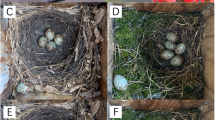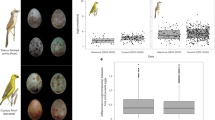Abstract
PARASITIC cuckoos habitually lay their eggs in the nests of one or more host species. Because changes in one member of a host-parasite pair select for changes in the other member, it has been suggested that there is a revolutionary arms race between cuckoos and their hosts1–6. Comparisons of host species with species unsuitable as hosts, and the finding of host species from allopatric populations that tolerate nonmimetic eggs better than do species from sympatric populations, indicates that host behaviour has evolved in response to the behaviour of cuckoos5. Similarly, the observations that the laying procedure of cuckoos matches host defences2, and that cuckoo egg mimicry parallels the discriminatory ability of the host species7, indicates that cuckoo behaviour has evolved in response to host counter-adaptations. Here we demonstrate that rejection of eggs of the parasitic great spotted cuckoo Clamator glandarius by the magpie Pica pica hosts varies between populations depending on cuckoo parasitism. In a population of ancient sympatry, magpies reject both nonmimetic and mimetic eggs; in an area of recent sympatry magpies show less rejection, particularly of mimetic eggs; in a population isolated from great spotted cuckoos, however, magpies show no rejection. Such differences in egg recognition among host populations affect the spatial population dynamics of parasites and their hosts. Parasitic cuckoos therefore are in a particularly favourable posiá-tion in the revolutionary arms race with their hosts in areas of recent sympatry.
This is a preview of subscription content, access via your institution
Access options
Subscribe to this journal
Receive 51 print issues and online access
$199.00 per year
only $3.90 per issue
Buy this article
- Purchase on SpringerLink
- Instant access to full article PDF
Prices may be subject to local taxes which are calculated during checkout
Similar content being viewed by others
References
Dawkins, R. & Krebs, J. R. Proc. R. Soc. B205, 489–511 (1979).
Davies, N. B. & Brooke, M. de L. Anim. Behav. 36, 262–284 (1988).
Mason, P. & Rothstein, S. I. Evolution 40, 1207–1214 (1986).
Payne, R. B. A. Rev. Ecol. Syst. 8, 1–28 (1977).
Davies, N. B. & Brooke, M. de L. J. Anim. Ecol. 58, 207–236 (1989).
Moksnes, A. & Røskaft, E. Behav. Ecol. Sociobiol. 24, 25–30 (1989).
Brooke, M. de L. & Davies, N. B. Nature 335, 630–632 (1988).
Cramp, S. (ed.) The Birds of the Western Palaearctic Vol. 4 (Oxford University Press, 1985).
Soler, M. Ornis Scand (in the press).
Bishop, Y. M. M., Fienberg, S. E. & Holland, P. W. Discrete Multivariate Analysis (MIT Press, Cambridge, Massachusetts, 1975).
Kelly, C. J. theor. Biol. 125, 283–299 (1987).
May, R. M. & Robinson, S. K. Am. Nat. 126, 475–494 (1985).
Mayfield, H. Living Bird 4, 13–28 (1965).
Post, W. & Wiley, J. W. Condor 79, 176–184 (1977).
Rowan, M. K. The Doves, Parrots, Loeries and Cuckoos of Southern Africa (David Philip, Cape Town, 1983).
Yamagishi, S. & Fujioka, M. Tori 34, 91–96 (1986).
Author information
Authors and Affiliations
Rights and permissions
About this article
Cite this article
Soler, M., Møller, A. Duration of sympatry and coevolution between the great spotted cuckoo and its magpie host. Nature 343, 748–750 (1990). https://doi.org/10.1038/343748a0
Received:
Accepted:
Issue Date:
DOI: https://doi.org/10.1038/343748a0



